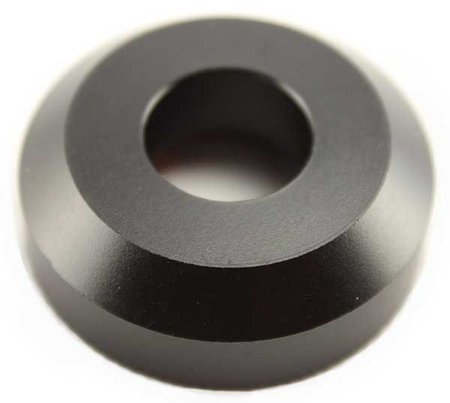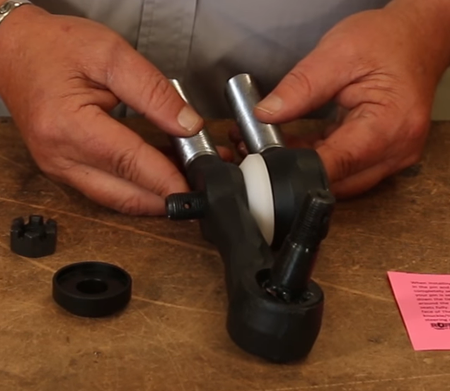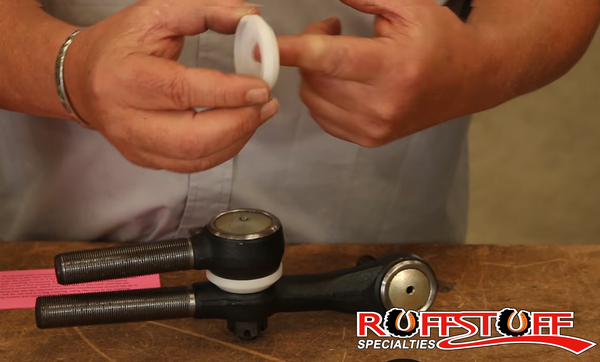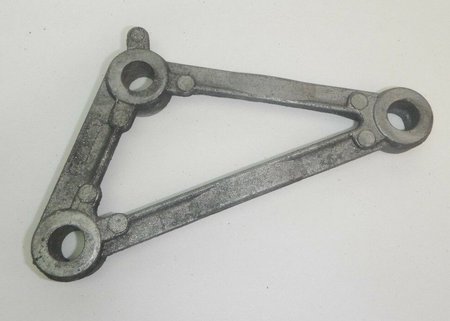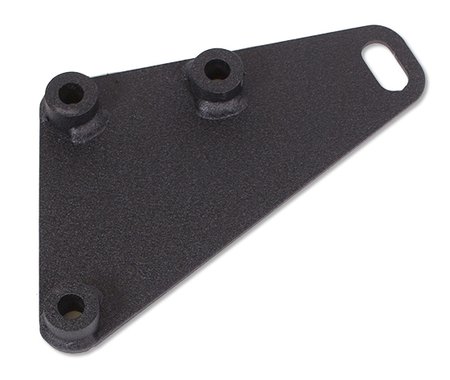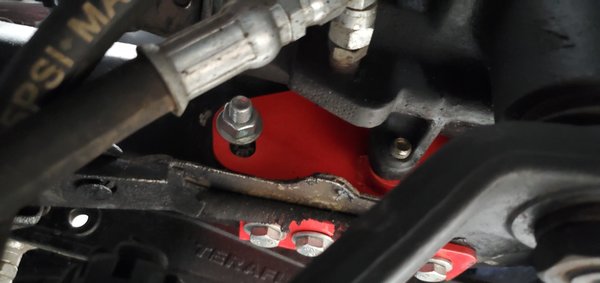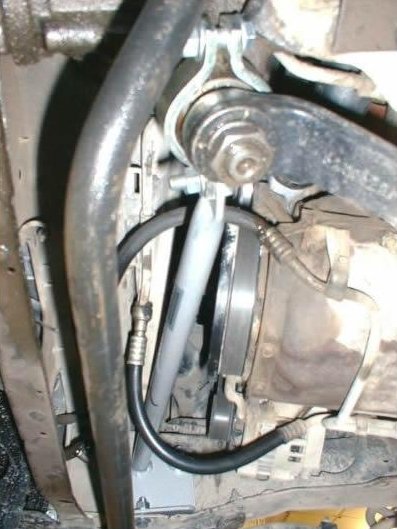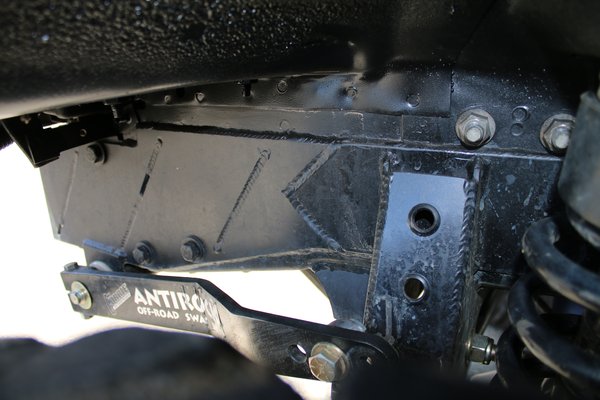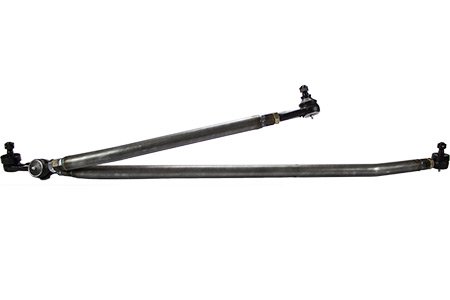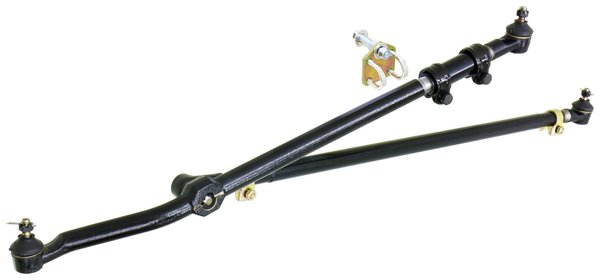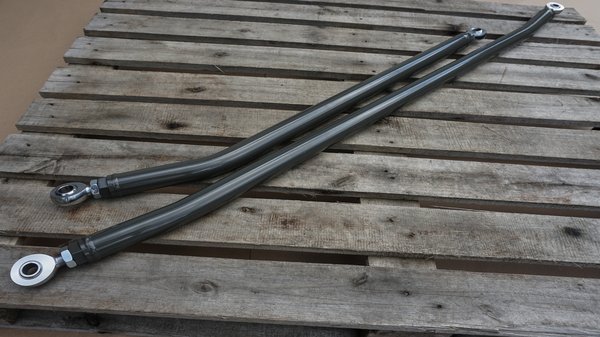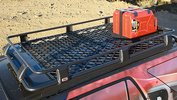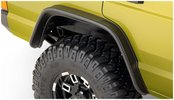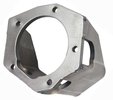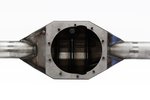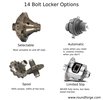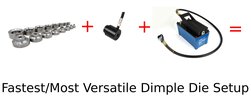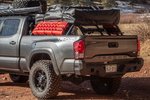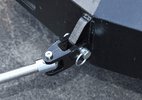Jeep XJ Steering Upgrades: Beef Up Your Cherokee
Once you start running big meats on your XJ, you're going to notice something:
The stock steering is terrible for big tires.
Besides being weak, it'll often feel loose or sloppy - and have some bad handling.
There are a few different options out there for upgrading your Jeep XJ's steering, so we're going to take a look at a few of them and why you might choose one over the other.
We'll start off with simpler, cheaper ways to improve your steering, then look at some beefy 1 ton upgrade options.
- 3 Jeep XJ Frame Stiffeners to Keep Your Cherokee From Tearing Itself Apart
- Wiggle parts around with a crowbar: Try to find loose bushings. The track bar is often loose or needs new bushings.
- Check the steering box: It'll loosen up with age, but you can tighten it up. It might also need a rebuild.
- Inspect the frame around the steering box for cracks and check the tightness of the mounting bolts. This is an area of the unibody that often needs to be reinforced.
- Use RuffStuff's "The Cure" bushing/boot (from RuffStuff Specialties)
- Replace the dinky stock aluminum steering box spacer with a steel one (from JcrOffroad)
- Add a steering box brace (from M.O.R.E.)
- Upgrade your XJ to 1 ton steering (from RuffStuff or Currie Enterprises)
- Consider Jeep XJ frame stiffeners for the unibody
- Make the XJ's unibody more rigid
- Provide thicker mount points for links, crossmembers, etc.
- Removing the drag link from the tie rod
- Removing the rubber boot from the drag link end (and toss it)
- Install "The Cure" in place of the rubber boot
- Reinstall the drag link
- 1984 to 2001 XJ Cherokee
- 1997 to 2006 TJ Wrangler, Rubicon and Unlimited
- 1986 to 1992 MJ Comanche
- 1987 to 1996 YJ Wrangler
- 1993 to 1998 Jeep Grand Cherokee ZJ
- Strong steering
- No death wobble
- Reasonable articulation while fourwheeling
- Drill them straight out to 5/8" or 3/4": This allows you to use a 5/8" or 3/4" heim joint.
- Use a taper reamer to resize to a 1.5" per foot taper: This allows you to use the 1 ton GM tie rod ends/drag link ends.
- DOM tubing: Kits with Drawn Over Mandrel Tubing tend to come in 1.125" diameter to 1.5" diameter sizes.
- Solid tubing: There is one kit out there with a solid steel drag link and tie rod!
- Ream the knuckles and pitman arm with a 1.5" per foot taper reamer
- Bolt on the tie rod and drag link
- Ensure you have a stock pitman arm
- Bolt on the tie rod and drag link
- Drill the knuckles and pitman arm to 5/8"
- Bolt on the tie rod and drag link in a UTK or OTK configuration
Common Problems
Big tires can result in big death wobbles.
While some of this is due to the Cherokee's puny steering and not amazing design, sometimes it's just poor maintenance. A few things you can do are:
Follow This Upgrade Plan
The basic sequence we'd follow for upgrading your XJ's steering looks like this:
Before you upgrade to 1 ton steering, it's really important to strengthen the steering box mount with a steel spacer and a brace to keep the box frame ripping off the thin unibody.
If you're going to throw on some big tires or do serious wheeling, you should very much consider welding on frame stiffeners to:
The Cure: RuffStuff's Cheap Solution to Less Jeep XJ Steering Slop
The cure eliminates a whole lot of slop from your drag link flopping around. Fits stock 5/8" steering or 3/4" 1 ton steering.
The Cure also comes with a 3/4" ID for 1 ton GM TREs.
If you're just looking to get rid of some steering slop, RuffStuff Specialties patented a little disk they call "The Cure". It's a piece of Delrin that sandwiches between the drag link and the tie rod.
This doesn't just fit Jeep XJ Cherokees, it fits other Jeeps as well, plus 1 ton steering setups.
The way it works is simple:
Lots of Jeeps have a little dead spot in their steering. This occurs when you're turning the wheel, the drag link moves, and the drag link "flops" from front-to-back (of back-to-front) of the tie rod.
You can also install The Cure on 1 ton steering on your XJ to tighten it up.
That little extra flop is the source of your dead spot, and happens because the stock rubber drag link end boot is soft and flexy - Delrin is harder, smooth, and self-lubing, so that you won't have that flop.
Installation is simple:
The Cure is only for use at the junction of the drag link and tie rod - not at the knuckles or pitman. That means you only need one.
By replacing the soft rubber boot with the harder Delrin, the drag link doesn't shift every time you turn the steering wheel.
The Cure fits a bunch of different Jeeps:
Note!
Sometimes, you may need to shave or trim The Cure down to get it to seat correctly.
The
ID for the Jeep XJ Cure is 5/8". Since 1 ton steering for XJs can have a
similar flopping problem, RuffStuff also makes it in a 3/4" ID for 1
ton steering.
Apparently, there is a rubber/steel stock part for older full size Jeeps that is very similar to The Cure, but we don't have the part number.
The Cure for Jeep CJ/YJ/XJ/TJ - 5/8" ID
The Cure for GM 1 Ton Steering - 3/4" ID
Reinforce It
1) Replace Your Stock Cracked Steering Box Spacer
Do you want this little thing between your XJ's unibody and steering gear? Nope.
This CNC-cut spacer replaces the stock XJ aluminum spacer. It's powdercoated and bolts-in - no drilling or welding.
Did you know that your XJ has a steering box spacer sandwiched between the frame and the box?
It's aluminum, skeletal-looking, and breaks a lot on even moderately-wheeled rigs. It probably tends to crack on XJs where the unibody experiences a lot of flex. The cast aluminum isn't ductile, so it cracks instead of bending.
This is a must-fix if you plan to run big tires or do hard wheeling.
The red plate in the top of this photo is the steering gear spacer. It'll stiffen the unibody up and is stronger and more ductile than the aluminum spacer.
But it's an easy fix:
Replace it with a steel steering box spacer.
It's
as simple as unbolting your steering box, slipping out your sad, broken
aluminum spacer, and replacing it with a new steel spacer.
Do you need it?
Yes, a spacer and a brace are probably the first things you should upgrade in your steering if you're running big tires or a locker.
A steel replacement steering box spacer for your XJ, like the one from JcrOffroad, will hold up however long you want to wheel your rig.
This is a bolt-on part - no drilling or welding required.
The JcrOffroad spacer is CNC-cut from 3/16" steel plate and powdercoated to last without rusting. It also includes mounting hardware - it's a good idea to use red Loctite on the bolt threads so they don't work loose.
2) Hold Your Steering Box in Place with a Steering Box Brace
M.O.R.E.'s brace bolts-on and requires you to enlarge only one hole for installation.
Do you like the idea of ripping your XJ's steering box off your frame?
Probably not.
That's why you need a steering box brace for your XJ.
This steering box brace from M.O.R.E. secures your steering gear up against the frame rail to keep it from tearing off.
The brace bolts around the sector shaft casting on the steering box and then ties into the frame on the passenger side. There are weld-on and bolt-on braces, but we think the best brace is a bolt-on - it's much easier to install.
Do you need it?
If you're going to run big tires or a locker on your XJ, this is another must-do with a steel spacer.
The M.O.R.E. steering brace bolts on easily. You don't need to make any mods other than enlarging one frame hole to 7/16".
To see how easy the installation is, check out the instructions.
3) Reduce Unibody Flex with Frame Stiffeners
RuffStuff's front stiffeners come in 3 pieces per side to make them easier to install. The reinforcement plates fishmouth together where they meet.
The XJ's unibody construction is infamous for its flexibility.
Get too crossed up on a trail, and you might not be able to open your doors.
While frame stiffeners aren't a direct steering upgrade, they're something to consider if you're going to be doing hard wheeling. They'll decrease the overall frame flexibility in your XJ, which is a good thing if you want tight steering.
They complement large tires that put lots of leverage on your suspension, and they also give you a solid place for mounting suspension points, rock sliders, and drivetrain mounts.
We're showing just the front frame stiffeners from RuffStuff here, but you can plate your XJ's frame from the front to the rear if you want.
Jeep XJ Steering Kits - WHAT TO LOOK FOR
If your want to substantially improve your XJ's steering and strength, take a look at putting in a kit that has bigger tie rod ends (or heims), a bigger tie rod, and a bigger drag link. Most XJ owners that are upgrading to 1 ton steering are looking for 3 things:
Let's just note here:
If you're looking at 1 ton steering for your XJ, that means you already have a steel steering box spacer installed along with a steering box brace, at the least. If your tires and lift justify huge TREs and links, we're assuming you've done the basic reinforcement that every XJ wheeler should do.
Now:
Depending on your Jeep, the Dana 30 or Dana 44 steering linkage leaves a lot to be desired in terms of strength and handling.
So, there are a few ways to achieve these goals and different manufacturers have different takes on the best steering system. So, here are some thought and facts:
Do You Need Crossover Steering?
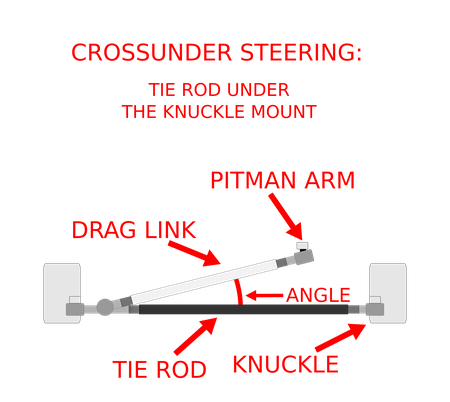
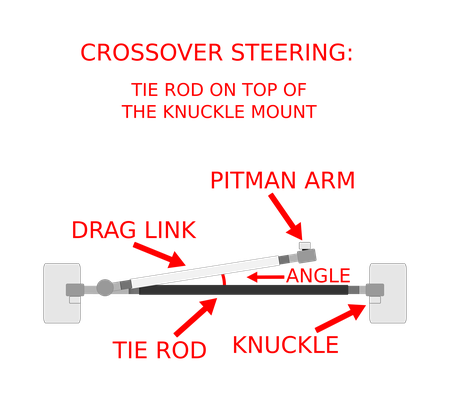
With crossunder steering the tie rod is mounted under the knuckle mount. This is an extremely common mounting on all types of solid axle 4x4s. The tie rod is low and vulnerable to rocks, which is why many upgrades make the tie rod super thick.
With crossover steering you get better angles and your tie rod is up and out of the way. But it's usually more work and requires some drilling or light fabrication.
If you're lifting your XJ over 4-6" you should look into crossover steering.
On a stock Jeep Cherokee XJ, the tie rod is mounted under the knuckles.
If you upgrade your steering to "crossover" style, the tie rod is moved to the top of the knuckles.
What's the difference?
There are two important things:
First, when the tie rod is moved on top of the knuckle, it's out of the way of rocks and obstacles that might bend it when you're out on the trail. This is a good thing if you're doing a lot of trail time, but we don't see it as hugely essential.
While there's been a pretty big trend to go with crossover steering for all types of 4x4s, there are plenty of people doing low-lift, big-tire builds that stick with the low steering. It's not too hard to gently winch or drag out a bent tie rod on the trail anyway.
The second thing to think about is "How high is your lift?". The higher you lift your suspension, the more extreme the drag link angle becomes.
The ideal setup for your XJ would be that your tie rod and drag link would be parallel. Of course, this is the real world.
That ain't happenin' and the drag link is angled even in the stock configuration.
However, if you move up the tie rod, you can flatten the angle between the tie rod and drag link and improve your steering. Most crossunder XJ steering upgrades are rated for around 4-6" of lift. You may be able to go bigger, but realize that there'll be compromises in your steering.
If you need to drop your angle, many lift kits come with drop pitman arms, or you can pick one up separately.
Tie Rod Taper
From the factory, your Cherokee will have a 5/8" taper at the pitman arm and knuckles. If you're breaking tie rod ends, or think you might, the best thing to do is make them bigger!
You have generally have two options here:
We'll talk more below about tie rod ends vs heims, but let's talk about the drilling and tapering first.
Neither option is particularly difficult. If you're going to drill to 5/8" or 3/4" you need a 1/2" drill. Go slowly, use oil to lube the bit as you drill - there isn't much to it.
Tapering? It's a tiny bit trickier, but not much.
You need a taper reamer and, again, a 1/2" drill. Put the taper reamer in the hole and apply pressure while drilling. Use lots of oil.
With the taper reamer, you want to focus on keeping the drill square to the knuckle or pitman and test fit the tie rod or drag link end frequently while reaming.
Very important!
GM tie rod ends and drag link ends have the same taper (taper is the change in diameter along the length), but the end diameters are different - make sure that you're constantly test-fitting so you don't over-ream!
Tie Rod Ends vs. Heim Joints

Generally, we recommend TREs for street-driven rigs and heims for fourwheeling when you need the strongest possible strength.
Ah, the great debate, TREs vs. heims. A general rule of thumb is this:
TREs for the street, TREs or heims for fourwheeling.
Tie rod ends are a ball joint mounted in single shear with a tapered joint. They're secured with a jam nut on the shank and a castle nut and cotter pin on the tapered side.
They have zerks that can be filled with grease, are easily available, and the 1 ton joints you'd use in an Jeep XJ are super strong.
Heim joints are a ball joint mounted in single or double shear with a straight joint. Instead of a tapered "pin", they have a straight through-hole. They're secured with a jam nut on the shank end and bolted with a bolt in the through-hole.
Heims are good for when you need tons of steering articulation. If you can mount them in double shear, they'll be stronger than a comparable tie rod end.
"Farm" type heims aren't great for running on a Cherokee - you should look for some higher quality teflon-lined heims that have the tight tolerances you want in your steering.
We prefer tie rod ends for an XJ that's going to see a bunch of street use. TREs last longer and you don't have to worry about keeping the joint tight. (You could safety wire your heims, but we don't see a lot of people doing that in practice.)
TREs might have a little less articulation, but they're fine in an XJ when you use the high-misalignment GM 1 ton joints.
Tie Rod and Drag Link Tubing
For most steering upgrade kits, XJ Cherokee owners have two options:
Which one should you get?
Strengthwise, the options are ordered like this:
| Strongest | Solid 1.5" Rod |
|---|---|
| Middle | 1.5" DOM tubing, 0.25" wall |
| Weakest | 1.125" DOM tubing, 0.25" wall |
It shouldn't come as a huge surprise that bigger and thicker steel is stronger than smaller, thinner steel. But it's a little more nuianced than that.
Structually speaking, when a tube or rod needs to resist a bending load, the majority of the load is carried furthest from the center of mass - in other words, looking at the end of a steel rod, the outside of it does the most work. You can eliminate much of the inside and still get comparable strength.
So:
While the solid rod is ultimately stronger than the 1.5" 0.25" wall tube, it's not going to make a huge difference out on the trail. If you're waffling between a couple of steering upgrade kits for your XJ, tube or solid probably shouldn't be the deciding factor.
If you're making your XJ into a lightweight trail rig, round tubing is an easy area to kill some weight while keeping your steering strong.
Tie Rod Dent Resistence
With a sufficient diameter, you can make your tie rod super resistant to bending. But if you want it to be truly strong, you need it to be thick.
A thin tie rod that gets dented will weaken and bend at the dent.
Make sure that any steering kit you put on your XJ uses at least 1/4" wall tube if you need strength upgrades in your steering.
Steering Upgrades for Jeep XJ Cherokees
Jeep XJ 1 Ton Steering Upgrade from RuffStuff
| Tie Rod/Drag link material | 1.5" 0.25" wall DOM tube |
|---|---|
| Link ends | GM 1 ton |
| Crossover/crossunder? | Crossunder |
| Fab required? | Taper ream knuckles and pitman |
This kit from RuffStuff Specialties ticks all the boxes for us. It comes cut and welded, it's relatively painless to install, it's strong, and it fixes your steering.
The kit uses the common 7/8" shank GM 1 ton tie rod and drag link ends. The pitman end is high-misalignment.
It does have a crossunder tie rod, but it uses large 1.5" 1/4" wall DOM steel tube - at that size it'll be dent and bend proof for all but the worst abuse. With a crossover tie rod, you'd also need to do more work to your knuckles.
This is a complete 1 ton steering setup for your XJ, from the steering box to the knuckles.
To install it, you need to:
It's made in the USA.
Need a 1 ton DIY kit that you you weld yourself? It's cheaper and more flexible if you've got a custom setup. Use this kit.
Need an even stronger kit with 3/4" heim joints? It's also DIY cutting and welding. Use this kit.
Currie Heavy Duty Jeep Tie Rod System
| Tie Rod/Drag link material | 1.25" solid steel alloy |
|---|---|
| Link ends | 7/8" shank with factory taper |
| Crossover/crossunder? | crossunder |
| Fab required? | Bolt-in |
This is a bolt-on kit that works with 2-6" of lift. While it doesn't look to us like it should work very well, lots of people love this kit and say that it's made a big difference in the handling of their XJ! Fair enough.
It uses a factory-style T setup, super strong parts, and is set up for crossunder steering.
It's definitely the easiest kit to install - no drilling or reaming are required to put it together.
The tie rod and drag link are solid alloy rod and the TREs have the factory taper. While Currie says this kit is 200% stronger than stock, our concern is that a snapped tie rod end could put you in a pickle.
The drag link in particular has an integrated end that would require replacement of the whole rod when it wears out.
The kit expects you to use stock parts from knuckles to pitman arm. That means that if you have a lift kit with a dropped pitman, you'll want to dig out your stock one and reinstall it.
To install it, you need to:
CavFab Jeep XJ Crossover Steering
| Tie Rod/Drag link material | 1.5" solid rod |
|---|---|
| Link ends | 5/8" heim |
| Crossover/crossunder? | both |
| Fab required? | Drill knuckles and pitman |
This kit from CavFab replaces your tie rod and drag link with solid 1.5" diameter steel rod! Both will both definitely resist bending more than any other XJ steering kit.
This kit does not use tie rod ends - it uses 5/8" heim joints. Teflon-lined alloy heim joints will last longer than plain steel, but tie rod ends will last longer than these heims.
One of the benefits to this kit is that you can run the tie rod under the knuckle (like stock) or over the knuckle. You drill the knuckles once, out to 5/8" and can swap at will.
This is pretty handy, but if you're doing street miles, make sure you properly torque the heim bolts. Loose bolts can wallow out holes, break, or just fall apart. There is no castle nut/cotter pin combo to retain the nut like a TRE.
To install it, you need to:
Made in the USA.
Last updated: September 5, 2019
